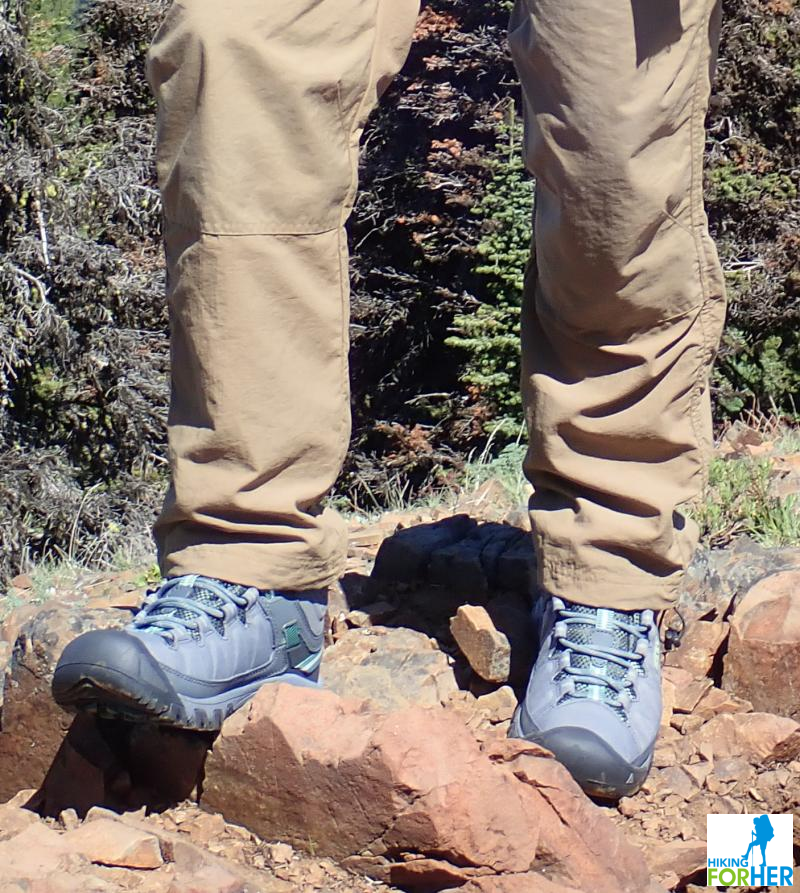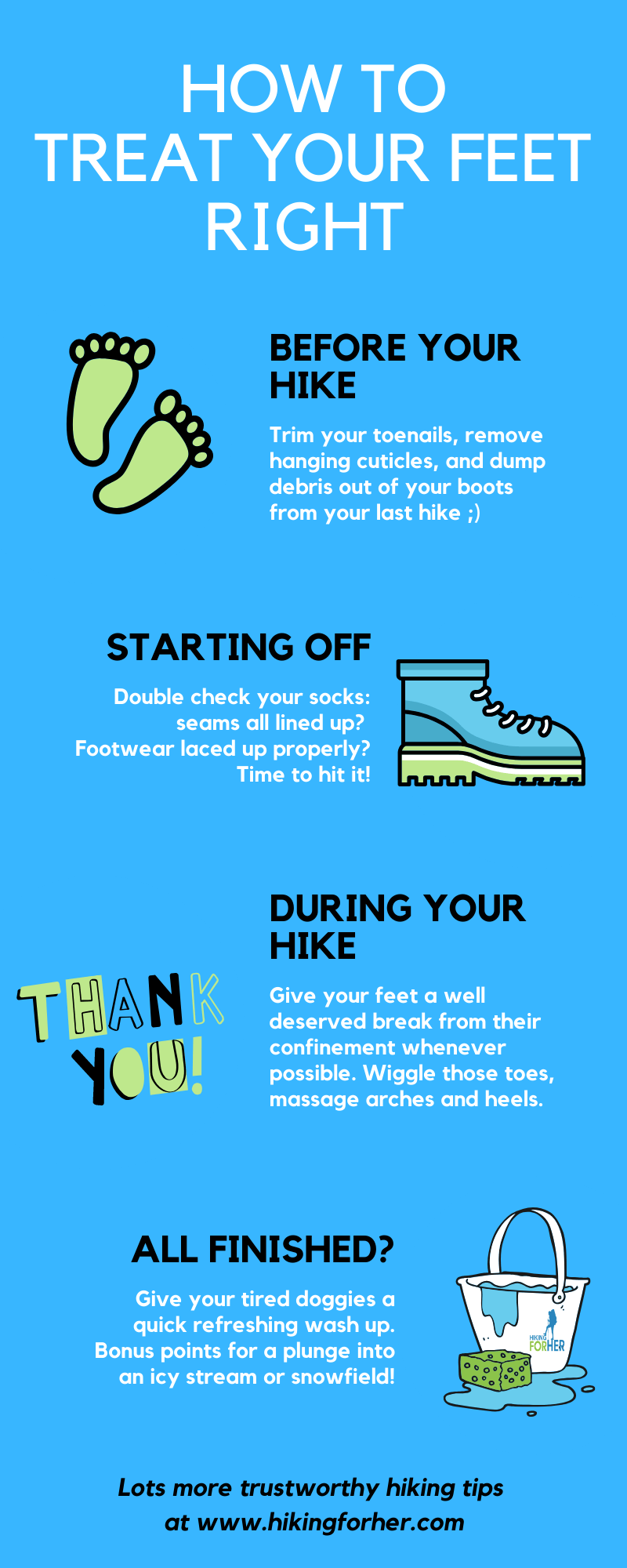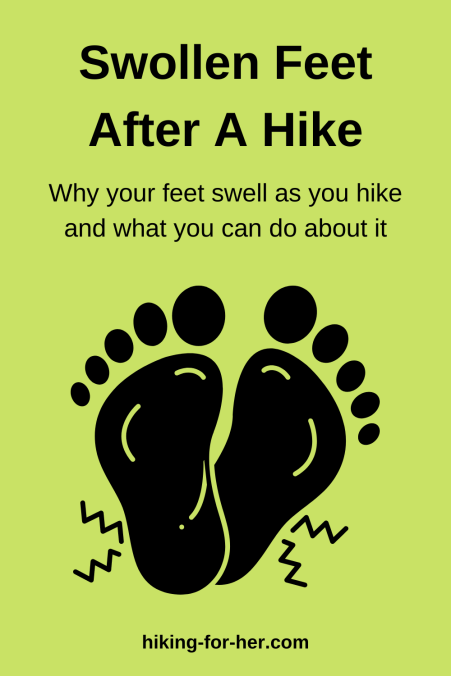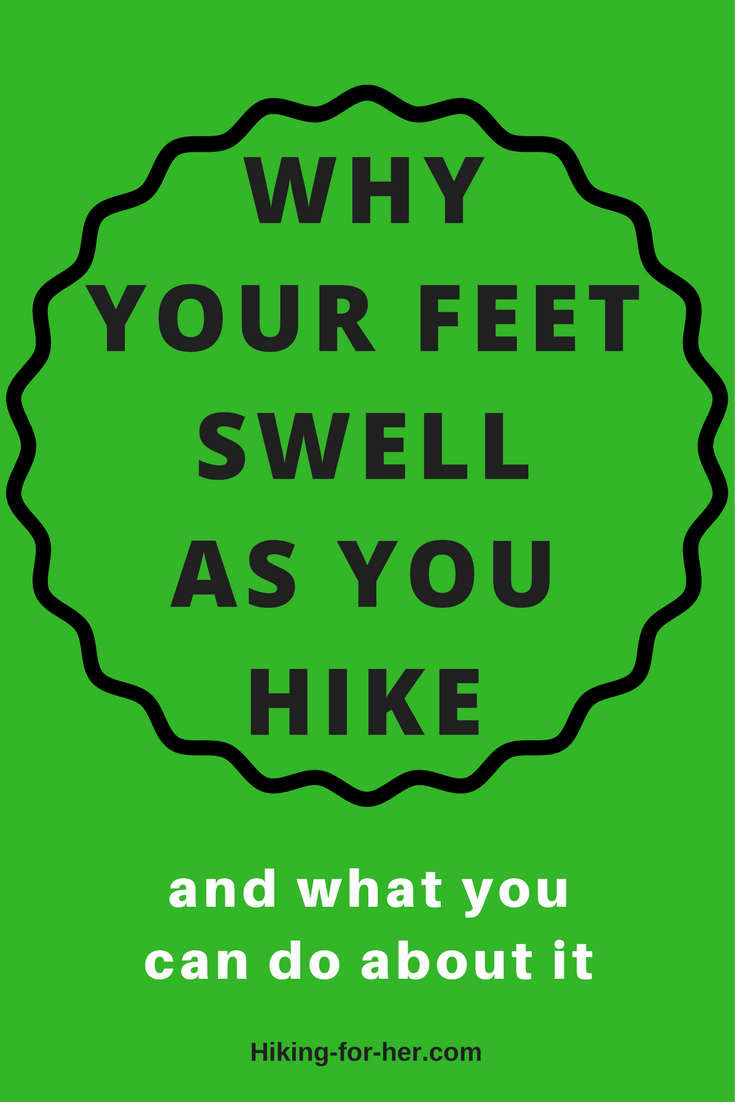
Swollen Feet After Hiking?
Here's What To Try
by Diane Spicer
Does everyone deal with swollen feet after hiking, or are you just lucky?
Great question!
I'm sure you've pondered it as you peeled off your stinky socks and gazed upon the huge blood vessels snaking across your tired feet.
(Sorry if that was too much information, but it's true, right?)
But swelling up is what brought you here, and sometimes it's not pretty. Let's tackle it anyway!
Find what you're looking for quickly:
Disclaimer
None of the information on this website is medical advice.
Use your own judgment, and visit your health care team for guidance and treatment if you experience swollen feet after hiking.
Why feet swell inside hiking boots
There are 3 things going on here to explain swollen feet after hiking.

Why your feet swell inside your hiking boots:
part 1
When you first pull on your hiking socks and thrust your feet into your hiking boots or trail shoes, you put pressure on the soft tissues and blood vessels in your feet.
Normal blood flow is changed by this compression.
- You may have "sock impressions" on your skin at the end of the day, especially from the elasticized tops.
Trail tip:
Make sure your socks aren't TOO tight, using the impressions-o-meter I just invented: deep grooves cut into your skin means you need different hiking socks.
Part 2
Here's a big factor in explaining your swollen feet after hiking.
As you hike, your blood vessels enlarge (increase in diameter) to bring more blood to your muscles, but this can lead to watery fluid escaping from the bloodstream and into the tissue spaces in your toes and ankles.
This fluid accumulation, called peripheral edema, is a normal process.
- Within a few hours of removing your socks and footwear, especially if you elevate your feet, the fluid should have returned to the bloodstream.
- The swelling will diminish and disappear as the fluid is returned to where it belongs (thanks, lymphatic system!)
Thing 3
about swollen feet after hiking
And the third factor in developing puffiness in the feet while hiking?
Your foot and ankle are bearing a heavy load under gravity, so fluid can pool in your ankles and toes when you don't sit down for several hours in a row.
Taking brief rest breaks and stopping for lunch are not enough time for the fluid to redistribute.
- So your feet will look swollen when your boots or trail shoes come off at the end of the hike.
So is this swelling of feet
a normal part of hiking?
For most hikers with normal circulation, mildly puffy feet or slightly swollen feet or ankles after hiking are nothing out of the ordinary.
This is especially true if you were on your feet for most of the day, wearing socks and trail footwear.
- Whenever you stand and sit, your blood flow will normalize and return excess fluid to your heart.
In other words, swollen feet after hiking should be temporary.
Health care notes
on swollen feet after hiking and beyond
But if you experience a lot of swelling that doesn't go away within a few hours when you stand and sit after your hike, your health care provider needs to know.
- There may be an underlying condition that is being made apparent by the fluid accumulation.
- It's important to visit your doctor if you also have swollen lymph nodes, are short of breath, and are losing weight.
If you have pain associated with this swelling, this is also not the normal increase in size associated with hiking.
Be careful to differentiate this from
the expected sore feet from hiking. If it seems to be an extreme amount of pain:
- Get some medical attention ASAP, especially if you have pre-existing conditions.
What if it's only one swollen foot?
One swollen foot may indicate an underlying physical problem which was tweaked or exacerbated during the hike.
Example:
- Locate the pulse point on the top of your affected foot, using your index finger to press down until you can feel the pressure from your blood flowing through the vein.
- If you can't locate a pulse, or it feels very thready or weak, there may be a circulation problem such as a blood clot.
A swollen ankle and/or foot on one side or the other could also be pointing to a fresh injury.
Bottom line:
If only one of your feet and ankles is swollen during or after a hike, you need to get a medical expert to evaluate it.
Asymmetrical as well as bilateral (both sides) swelling could be a sign of a life threatening problem and time is of the essence in order to get appropriate medical attention.
You'll want your health practitioner to rule out:
- heart disease
- liver disease
- kidney disease
- high blood pressure
- deep vein thrombosis
- venous insufficiency
Taking care of your feet as you hike
All of us want to avoid swollen feet after hiking.
And it has to start with awareness.
Do you ever think about the well being of your feet, trapped inside your trail footwear hour after hour?
Fresh air *gasp* and a bit of love is all they ask for in return for carrying your body and your backpack every step of the way.
Maybe swelling up is their plea for help!
Here are some foot care ideas to try on your next hike.
Great foot habits for any hiker
You might stuff your feet into your boots and forget about them.
But they're doing a lot of work for you.
Do some in return!
- Wiggle your toes in your boots every few minutes as you hike. This helps move fluid out of them.
- Notice if you're a "toe clencher", and make an effort to relax your feet as you're striding down the trail.
- Let your trekking poles bear some of the load.
- Pay attention to how you lace your boots. It can make all the difference in how much swelling you experience in your feet and ankles on a hike.
If you know that you'll be off your feet for longer than ten minutes, remove your boots and hiking socks.
- Put your feet up on the nearest log, or propped up on top of your backpack.
- Take a good look at any sore spots, and read these tips for dealing with sore feet.
- Resting near a cold stream or snow field? Cold water hydrotherapy not only feels great, but keeps inflammation levels lower.
More good foot care tips for you!
And here's a discussion of another way to reduce swelling during a hike: the best hiking compression socks.
Because your feet are connected to your calves, here are some tips for dealing with them when they're sore after a hike.
Does what you eat and drink affect
the amount of swelling on a hike?
It could, if you're drinking lots of water to stay hydrated but aren't taking in enough salt (sodium, an electrolyte) on a hike.
The technical term is hyponatremia.
- Hypo = low
Because salt helps your tissues absorb water, its low concentration allows water to build up and cause swelling.
But you'd have to drink a lot of water, and avoid salty trail snacks altogether, to get yourself into this situation, according to experts.
So be sensible.
The best strategy to avoid swelling on a hike is to snack when hungry on good trail food without overdoing your salt intake.
- Gorging on salty pretzels, probably not a great idea unless you can pack along or purify a lot of water.
Turn to other sources for moderate amounts of salt in food, like dried fruit or sardines, tuna or high quality jerky.
Use a good hiking hydration strategy, too.
Trail tip: Watch the color of your urine: go for pale yellow in large amounts to know that you're well hydrated.
Does what you wear on a hike matter?
Glad you asked!
Tight, non breathable clothing will restrict blood flow and can cause swelling on your extremities, around your waist and in the chest area.
Looser fitting clothing helps you move well on the trail, and allows better blood AND air circulation.
So avoid spandex, tight sports bras, restrictive shorts or pants, tightly cinched belts or cuffs, and close fitting waistbands.
Check that your backpack fits properly, and adjust the shoulder straps and sternum strap until the pack feels secure while not holding you in a death grip.
- You might find these best hiking clothing tips useful.
Exception
Now let's (slightly) contradict that information.
There's one item of hiking clothing you might want to be tightly fitted: those compression hiking socks mentioned above.
Experiment with whether it's best for dealing with swelling to wear the socks as you hike, or don them once you take off your boots.
- You will find the right approach to heading off swollen feet after hiking after a bit of trial (trail) and error.
What you can do about swollen feet
after hiking
So many things!!
Pick at least one of these and ... hmm, how does that saying go again?
Oh, yeah.
Just do it.
- Remove all constrictions as soon as possible on legs and feet: footwear, socks, ankle bracelets, toe rings.
- Consider hiking without the jewelry next time.
- Lie down and prop up your feet at a level above your heart. Use your backpack or bunched up clothing to make this more comfortable.
- Ask your hiking buddy to bring you some water and a tasty snack as you recline :)
- Be sure your feet really are higher than your heart. This might feel weird, having your head lower than your feet, but in the short term it helps the fluid drain from your extremities.
- Cold compresses can help decrease the swelling more quickly. Use icy cold stream water in your water bottle, a snow patch and your bandanna, or on demand activated cold packs from your first aid kit.
- If you're really thinking ahead to those swollen feet, you can use the ice from the cooler you stashed in your car at the trail head.
- As you're lying there, consider whether your hiking footwear is too tight, or your lacing system is too extreme. You might want to change that up a little and see if the swelling problem in your feet and ankles improves.
- Review your dietary intake of salt over the past few days, including this one. If you like salty food, you will retain water and have puffiness not only in your feet but face, hands, fingers and elsewhere.
- Also consider how tight your backpack straps are: hip belt, shoulder straps, or your sternum strap could be reducing normal circulation, causing fluid build up in your feet.
- If you are still swollen after a few hours, consult a health care provider to rule out blood clots, infection or other issues.
Another trail tip or two for swollen feet after hiking
If you find yourself with engorged feet after every hike, it may be time to do some exercises to improve circulation and range of motion in your ankles and feet.
It's not a huge time sink, and you might notice an improvement in your swollen feet after hiking!
- Take a look at these 6 easy exercises to tackle the swelling.
Maybe it's time to switch out your hiking footwear. Heavy hiking boots can be replaced with lightweight trail shoes.
Or less supportive shoes can give way to more support in a well designed boot.
- Read more about best hiking footwear choices.
Swollen hands and fingers
after a hike, too?
This is something every hiker faces, to one degree or another.
To figure out if this is normal, or if it's something that should be brought to your health care provider, read these tips on what to do when your fingers swell on a hike.
- If in doubt, a physical examination from your doctor will clear up the mystery.
And check out how to deal with hiking inflammation, a different scenario that can gift you with swollen feet after hiking in addition to pain, darkened skin tone, loss of function and more.
You want to be at your best on the trail, right?
Add one of these pins to your Pinterest boards to remind you of these tips for swollen feet after hiking!
Home page > Best Hiking Tips >
Tips For Swollen Feet After Hiking
|
I get emails all the time about what I wear, eat, carry and love to use on the trail. That's
why I provide affiliate links to you: the best gear that I use myself and have seen used by other hikers is instantly
available for your consideration, and the gear company sends a few
pennies per dollar to this reader-supported hiking website. There is no added cost to you! Everyone ends up a winner: Great gear for you, strong gear companies, and more free hiking tips for everyone. Thanks very much for your support. It's warmly and sincerely appreciated. It also helps send these hiking tips to all your virtual trail buddies around the globe. |
 |




